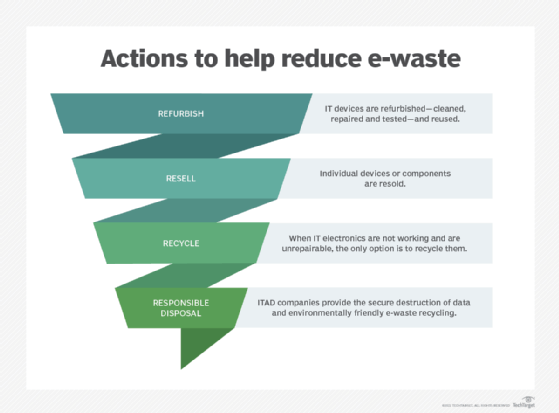e-waste (original) (raw)
What is e-waste?
Electronic waste, also known as end-of-life (EOL) electronics or e-waste, refers to discarded, recycled or refurbished electrical and electronic products. Correct disposal of e-waste is often included in a company's green computing strategy.
The U.S. Environmental Protection Agency (EPA) divides e-waste into 10 distinct categories:
- Large household appliances.
- Small household appliances.
- IT equipment.
- Consumer electronics, such as smartphones, televisions and computers.
- Light fixtures.
- Toys.
- Tools.
- Medical devices.
- Monitoring instruments, such as smoke detectors, thermostats and weight scales.
- Automatic dispensers, such as vending machines.
Common e-waste items
E-waste is the fastest-growing waste stream in the world today, with 80% ending up either in a landfill or informally recycled in 2017, according to a report from the Platform for Accelerating the Circular Economy, hosted by the World Economic Forum. Many of these devices either contain too many harmful materials to allow proper recycling or are simply discarded without any thought to proper recycling. More than 44 million metric tons of e-waste are created annually, according to the same report.
Small and large home appliances account for approximately 60% of all e-waste, according to a report from United Nations University. These include microwaves, vacuum cleaners, dishwashers, clothes dryers and electric stoves.
ICT, or Information and Communication Technology, equipment is the fastest-growing sector of e-waste. This includes laptops, smartphones, keyboards, computer mice and microphones.
Company business practices add to the e-waste problem. Forced, or planned, product obsolescence -- designing a product to fail after a certain amount of use or time -- continues into the 21st century because it increases sales, revenue and profitability.
Since its invention, the smartphone has become the most wasted electronic item on the planet. More than 5.3 billion smartphones were thrown away in 2022, according to the international Waste Electrical and Electronic Equipment (WEEE) Forum. The EPA, recognizing the growing problem of consumers routinely throwing out and replacing one- or two-year-old devices, is reviewing how it classifies commodities versus electronic waste.
Despite the staggering number of discarded phones in 2022, they -- along with other small EEE items such as electric toothbrushes, toasters and cameras -- account for only 8% of all e-waste.
Impact of e-waste
China, the U.S. and India contribute around 20 million metric tons of e-waste combined annually, both imported and exported. Part of the problem is poor care in disposal: It's estimated that only 17% of all e-waste is properly collected and recycled.
In fact, improper and unnecessary disposal of e-waste has a growing and quantifiable negative effect on the biosphere, human health, and national and personal security. Proper handling of e-waste is important, but its practice is controversial and can be highly dangerous to humans handling the e-waste.
Biosphere health
Many complex electronic devices contain up to 60 precious metals and elements. Separating and controlling these metals is extremely difficult and often hazardous to the biosphere. Melting down or incinerating electronic devices contributes to the increased presence of lead in landfills globally. Further, the emission of toxic fumes and gases is a leading factor in environmental degradation, climate change, pollution and contaminated water supply.
Human health
Items such as smartphones and computers contain several hazardous elements. Exposure to these toxic materials harms humans and can adversely affect the nervous system, heart, brain, kidneys, liver and reproductive system.
Many of these electronic appliances and devices contain high levels of lead, mercury and cadmium -- all known carcinogens. Waste management workers handle these hazardous materials. Exposure to them has been linked to lung disease, thyroid issues, birth defects, behavioral changes, and cancer in children and young adults.
Liquid-crystal display and plasma screens, each containing toxins and carcinogens necessary for their displays, are among the worst offenders. As a result of improper disposal and overburdened landfills, the risk of exposure has spread to more and smaller communities and their residents.
Security
In addition, the improper disposal and recycling of smartphones and similar devices has created an imposing threat to national and personal security. Smartphones and computers contain sensitive data subject to leaks and data breaches. Many of these devices contain highly classified and sensitive information, yet their easy-to-use nature makes hacking into them simpler.
Completely erasing sensitive data prior to discarding old devices is crucial in mitigating security threats. That's important to remember since 1 in 3 people in the U.S. have been victims of identity theft -- more than twice the global average -- according to a study by Proofpoint, a cybersecurity company.

Solutions to e-waste disposal
Despite the potential harm to the environment and individuals, recycling these items is an effective way to sharply cut e-waste. The following are proven ways to approach the problem:
- Bring EOL back to the company of origination. Many businesses that sell electronic items have their own recycling center. In addition, recycling there often gives the customer the option to trade in the device for a new one at a fraction of the cost.
- Donate old devices to a civic institution. Local schools, governments and universities are always in need of technology. Many of these institutions have specific days, times and locations for electronic donations, increasing the reuse of devices and lowering the chance of improper disposal.
- Look for buyback programs. Businesses such as Best Buy, Target and Walmart have instituted programs for buying back old devices. These programs are designed to make discarding old items as painless on the consumer and environmentally safe as possible.
- Sell the outdated technology. Facebook Marketplace, eBay and Craigslist have made selling old items easier. There are buyers who bid on old devices for several reasons, whether personal or professional.
- Search for nearby certified recyclers. There are numerous recyclers across the country certified by the Basel Action Network, a nonprofit recycling organization. These certified recycling centers almost always accept donations and are managed and staffed by industry professionals.
This was last updated in July 2023
Continue Reading About e-waste
- The CIO's key role in environmental sustainability
- ESG for IT: How CIOs can drive environmental sustainability
- Data center, devices scrutinized for sustainability goals
- Gartner: Use digital to achieve sustainability goals
- Sustainability and ESG glossary: 52 terms to know
 e-cycling
e-cycling  By: Kelly Richardson
By: Kelly Richardson  Cradlepoint embedded IoT connects AI-driven sustainable intelligent waste system
Cradlepoint embedded IoT connects AI-driven sustainable intelligent waste system  By: Joe O’Halloran
By: Joe O’Halloran  How to securely recycle enterprise computers
How to securely recycle enterprise computers  By: Marius Sandbu
By: Marius Sandbu  By: Katie Fenton
By: Katie Fenton